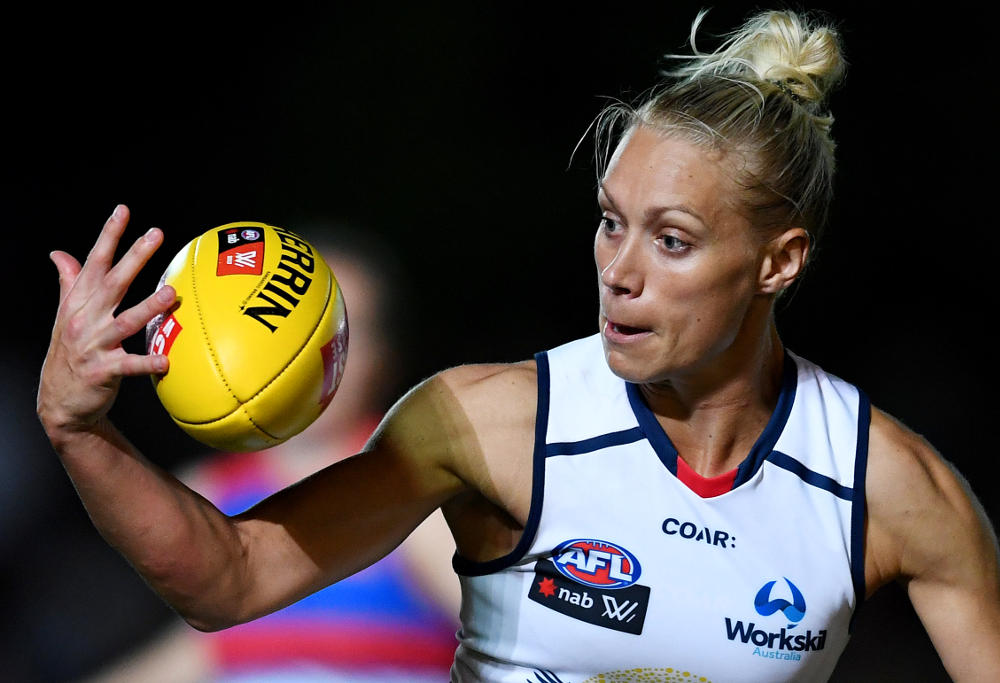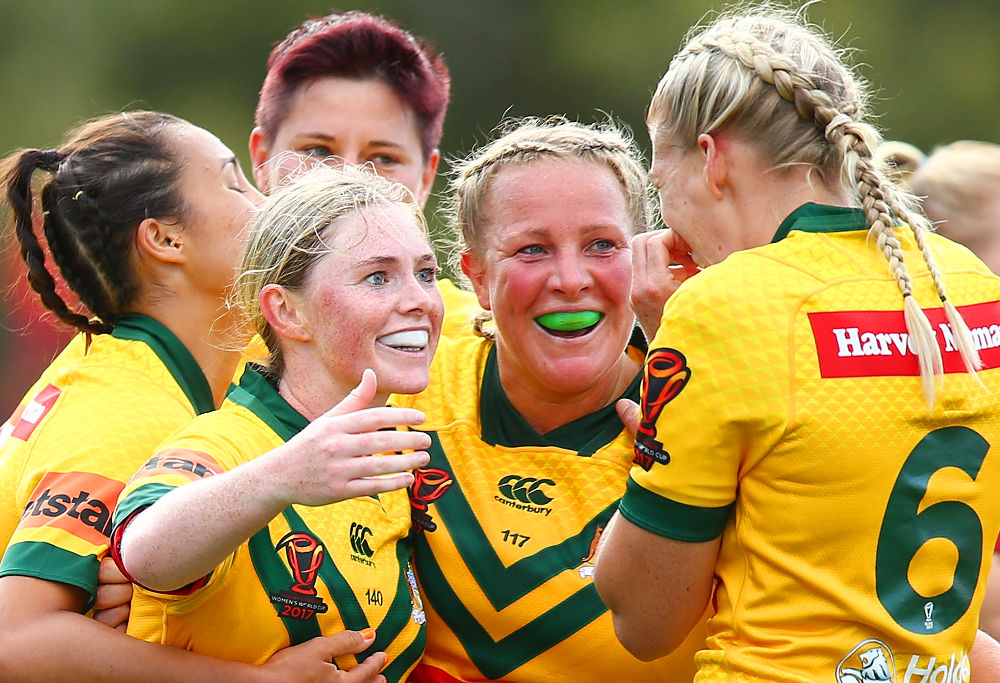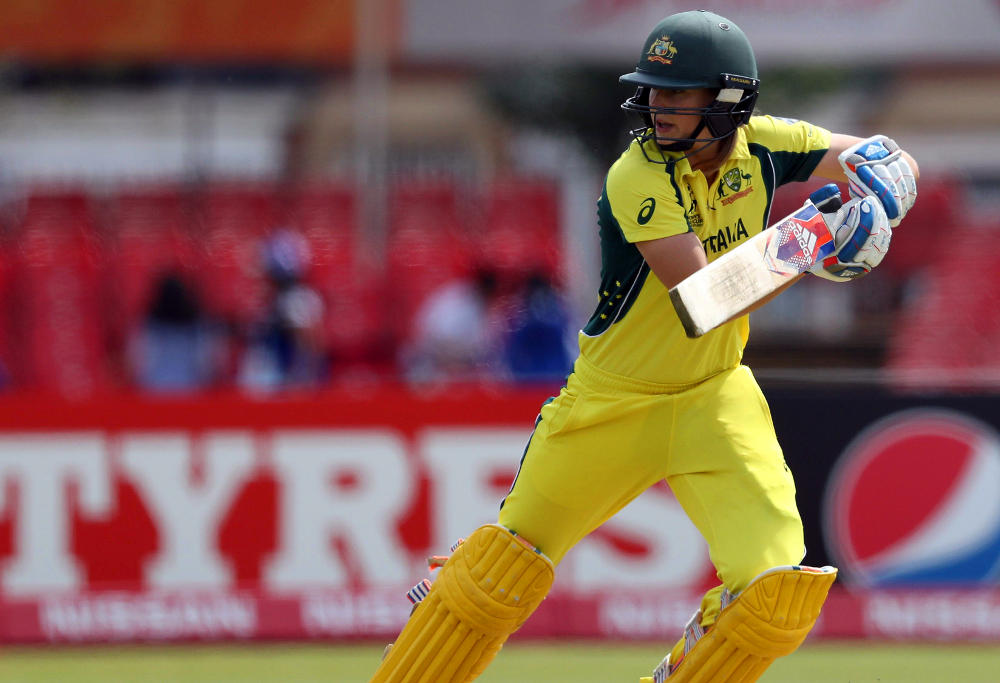JackJumpers' NBL title was special - but where does it sit among Tasmania’s top ten sporting moments?
It’s a pretty good time to be a Tasmanian sports fan right now. After years in the sporting wilderness with not much to celebrate,…

The year 2017 will forever go down as a watershed year for women’s sport in Australia, and with the NRL and Super Rugby set to launch their own women’s competitions in 2018, things will only get bigger and better.
From the raging success generated by the inaugural AFL Women’s season to the continued on-field excellence of the Matildas, there was a lot to celebrate on the female side of sport this year.
We start with AFL Women’s, where the season opener between Carlton and Collingwood at Ikon Park in February attracted a crowd of just over 24,500 – enough to the point where fans were locked out of the game by AFL CEO Gillon McLachlan, who was in attendance.
Led by four goals from Darcy Vescio and 26 disposals from Brianna Davey, the Blues won the inaugural AFLW premiership match by 35 points against their bitter rivals.
Such was the overwhelming success of that match, the Round 2 contest between Collingwood and Melbourne was moved from Olympic Park Oval to Ikon Park – thus creating a double header at the venue with the match therefore played following the Carlton versus GWS Giants showdown.
Television ratings and attendances remained strong throughout the duration of the season, while many players were praised for their skill level, aggression and approach to the game.
While the Brisbane Lions dominated the minor rounds, winning six of their seven matches (and drawing the other against Carlton), it was the Adelaide Crows, led by Olympic basketballer Erin Phillips, who claimed the inaugural AFLW flag with a seven-point win over the Lions in the grand final.
Phillips won just about every accolade possible – the players’ MVP, the AFLW best-and-fairest award, inclusion in the All-Australian team as well as co-captaining the Crows to grand final glory at Metricon Stadium.

(AAP Image/Tracey Nearmy)
Carlton forward Darcy Vescio led the goalkicking with 14 majors, while others such as Daisy Pearce, Brianna Davey, Katie Brennan and Moana Hope started to become household names in the fledgling league.
The outcome of the season could have been totally different had Melbourne not lost to the wooden spooners, the GWS Giants, by five points in Blacktown in Round 5.
That result was to ultimately cost the Dees a place in the grand final, and the missed opportunity will only spur them on as they bid to become the first Victorian team to win the AFLW flag in 2018.
Despite finishing last, as their men’s team did in their inaugural AFL season in 2012, the Giants were competitive in most matches, as evidenced in the Round 3 draw against Fremantle in which both teams pushed hard for the victory in the dying minutes.
The previous week, they led Carlton by 13 points in the final quarter before conceding 26 points to lose by that same margin.
While they have been tipped to again struggle in 2018, they did land Alicia Eva from Collingwood, while former Fitzroy coach Alan McConnell takes the reins from Tim Schmidt, who stepped down earlier this year for business purposes, as the club’s head coach.
Later on in the year, the Victorians would thrash the Allies by 97 points in the State of Origin match played at Etihad Stadium in September, with Vics captain Daisy Pearce starring with 37 disposals and Jasmine Garner kicking five goals.
It was later announced that the competition will be expanded to 14 teams by 2020, with the Geelong Cats and North Melbourne to enter in 2019, while the Gold Coast Suns, Richmond, St Kilda and West Coast Eagles will debut the following year.
The success of the AFLW indirectly led to questions as to whether, or if, rival code the NRL would follow suit.
After months of speculation, the NRL announced earlier this month that a women’s competition would be launched, with matches to be played in the lead-up to the men’s finals matches towards the back end of the season.
This comes on the back of the success generated by the Women’s rugby league World Cup, in which Australia defeated New Zealand in the final by 23-16.
The Jillaroos had won their preceding four matches by a combined scoreline total of 242-10, including back-to-back thrashings of Canada by 88-0 and 58-6 in the pool stage and semi-final, respectively.

(Photo by Mark Nolan/Getty Images)
The women’s grand final will be played as a curtain raiser to the men’s decider at ANZ Stadium on Sunday, September 30, while up to 40 female rugby league players will receive national contracts.
Among the teams favoured to receive licences include the Brisbane Broncos, St George Illawarra Dragons, Newcastle Knights, New Zealand Warriors, Melbourne Storm and Cronulla-Sutherland Sharks.
The establishment of the women’s league means the likes of Kezie Apps, Sam Bremner, Allana Ferguson, Ruan Sims, Talesha Quinn and Isabelle Kelly, among others, will finally get to realise their dream of playing in a professional women’s rugby league competition.
Staying on the football side of things, the Matildas made a statement on the world stage, going through the friendly-based Tournament of Nations undefeated en route to winning it, and defeating the USA for the first time.
The tournament was highlighted by Sam Kerr’s hat-trick of goals in the win over Japan.
Later in the year, the Matildas would contest two friendly matches against Brazil in Penrith and Newcastle in September, with both matches attracting sell-out crowds, while they would defeat China across two friendlies in Melbourne and Geelong in November.
A year of impressive results would see them finish the year ranked fourth in the FIFA World Rankings, their highest rank ever.
Surprisingly, though, Kerr was overlooked for the final three-player shortlist for FIFA Player of the Year, which ultimately went to the Netherlands’ Lieke Martens.
Women’s cricket continued to go from strength to strength this year, with the Southern Stars retaining the Ashes against England and the Sydney Sixers, led by Ashleigh Gardner and Ellyse Perry, posting a WBBL-record total of 4-242 on December 9.

(AAP Image/International Cricket Council)
That beat the previous record of 6-200 set by the Sydney Thunder earlier that same day.
Meanwhile, in the world of motorsport, Simona de Silvestro became the first female full-time driver in the Supercars Championship, and, in a male-dominated sport, held her own finishing 24th with 1,131 championship points.
Her best finishes were twin 13th-place finishes at Phillip Island in April, while she and David Russell were forced to retire from the Bathurst 1000 just nine laps short of the finish.
Another strong season of progress could see more female drivers enter the Supercars in the years to come.
It has also been announced that the Super W Competition would also launch next year, with teams to be included from New South Wales, Queensland, Victoria, the ACT and Western Australia.
The competition will run for five weeks, culminating in a final in April.
In addition, a bid to host the 2021 Rugby World Cup has also been lodged, this coming after the Wallaroos posted a modest record in the World Cup held in Ireland in August, finishing sixth after defeating the host country, as well as Japan, before losing to Canada in their final match in the tournament.
Those was just some of the highlights in what was without doubt a massive year for women’s sport in Australia, and if that was anything to go by, then 2018 will be another massive year.
The second season of the AFLW will start the way the first did, again with a match between Carlton and Collingwood at Princes Park, while the Adelaide Crows, as the defending premiers, will be the team to beat.
They will host the grand final rematch against the Brisbane Lions, also in the opening round, while Fremantle and Collingwood will have the honour of contesting the first football match of any kind at the brand new Perth Stadium in a free-to-air blockbuster in Round 2.
Further expansion following the 2018 AFLW season will make Australian rules football the sport with the largest women’s league in Australia by 2020 (by which point, fourteen teams will be in the league).
Meantime, exactly which clubs have won licences for the inaugural NRL Women’s season is set to be announced within the next month ahead of the season kick-off in August.
This leads me to finish the article with this question – would you like to see your favourite NRL team represented in the women’s competition?